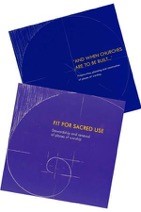Greetings Colleagues,
 This letter accompanies Bishop Bill’s gift to each parish/regional office of the two recently released documents from The National Liturgical Architecture and Art Council (NLAAC) of the Australian Bishops’ Commission for Liturgy.
This letter accompanies Bishop Bill’s gift to each parish/regional office of the two recently released documents from The National Liturgical Architecture and Art Council (NLAAC) of the Australian Bishops’ Commission for Liturgy.
‘And when Churches are to be built …’ Preparation, planning and construction of places of worship.
Fit for Sacred Use: Stewardship and renewal of Places of Worship.
The titles reference the Constitution on the Sacred Liturgy, articles 124 and 122 respectively.
The Australian Church should be proud of these fine documents. The organisation of the material and the presentation of each section and chapter provides clear principles to support and guide a community’s discernment when facing the significant opportunity of either building or renovating a Church or another sacred space. Indeed, they provide every reader with an opportunity to revisit and renew their understanding of who we are as Church, and the importance of our liturgical celebrations in shaping us for Catholic life and mission. It is most appropriate therefore that Bishop Bill gifts these books on our first Synod gathering day entitled ‘Building the Kingdom of God Together’.
The gift of the books is timely as an increasing number of parishes consider altering the worship space, specifically the sanctuary, to accommodate the needs of those who are aged or have a disability. It is important to be mindful of the significance of such changes particularly when the Church has a heritage significance.
As the books make clear, a church building is designed for a particular purpose, primarily the celebration of the Church’s liturgy by a worshipping community. This is why we dedicate Churches. As such, these buildings are not only subject to the usual requirements of all buildings in terms of safety, access, and good architectural and building standards, but they are also subject to the requirements of the liturgical principles and norms outlined in the accompanying books.
The Diocesan Liturgy Council recently sought advice from the NLAAC on the installation of handrails. The advice given was not to install any handrails unless a thorough Workplace Health and Safety Assessment is undertaken. The advice also indicated that the outcome of such an assessment would likely require the renovation of the entire sanctuary, as that would be the only way to ensure it complied with all legislation while maintaining its liturgical integrity. The point made was that unless you are going to do everything, do not do anything. Achieving such a balance is far easier when designing a new Church as can be seen at St Francis Xavier, Belmont.
In the face of this advice Bishop Bill has determined that rather than installing handrails, communities are to look to organising someone to accompany those requiring support to access the sanctuary, ambo or any other part of the worship space. Such a relational and communal response is more human, and therefore more liturgical. We serve each other in love. Anyone who comes to the Cathedral when Catherine Mahoney sings the psalm will have seen how this is done. For those who are do not know Cath, she is blind, and someone always accompanies her to and from the ambo.
The advice the DLC received from the NLAAC surprised us all and emphasised the need for communities to seek advice when building or renovating Churches and other sacred spaces. In the Diocese of Maitland-Newcastle, the Diocesan Liturgy Council is the Bishop’s advisory body on liturgical matters, and it is the community’s reference point on all such matters, large and small. As indicated above, the Council has access to other advisory bodies. This ensures that all communities have access to the best wisdom possible. As with any such process, it is preferable to engage with the Council early in the planning process so that a conversation can be facilitated with all interested stakeholders and professionals can be consulted as may be required.
You can make contact with the Diocesan Liturgy Council via the Diocesan Coordinator of Liturgy, Sr Louise Gannon, or via the Bishop’s Office.
Finally, if you wish to order additional copies of these books go to the Liturgy Brisbane website.
I encourage you to make good use of these books. Read and ponder.